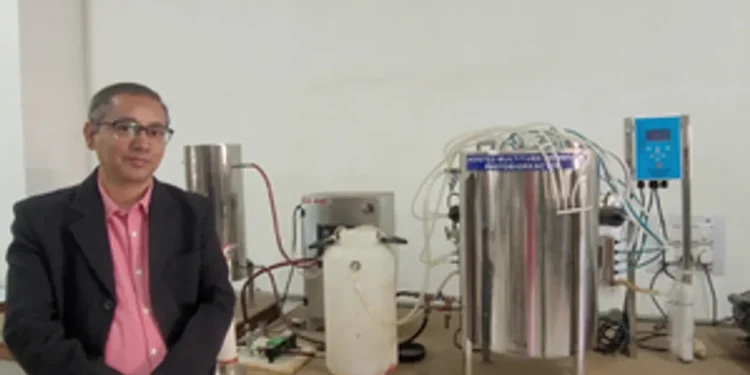A research team from the National Institute of Technology Rourkela (NIT-R) has successfully developed an advanced wastewater treatment system capable of efficiently removing persistent industrial dyes such as Bismarck Brown R. This breakthrough technology has earned the team a patent, marking a significant step forward in sustainable wastewater management.
The team, led by Prof. Sujit Sen from the Department of Chemical Engineering, comprises research graduate Madhumita Manna from NIT-R and former IIT-Kharagpur professor Binay Kanti Dutta. They have pioneered a cutting-edge treatment system that integrates nanocomposite-based ceramic membranes with microbubble technology to enhance the dye removal process.
Conventional wastewater treatment methods, such as ultraviolet light-based techniques, often face challenges in large-scale applications due to difficulties in separating dye particles from water. To address these limitations, the NIT-R team designed a hybrid system combining two advanced technologies for more effective treatment.
The system uses a specially designed ceramic membrane coated with an industrial waste-derived zeolite and zinc oxide (ZnO) nanocomposite. This nanocomposite acts as a photocatalyst, breaking down dye molecules when exposed to light. Meanwhile, microbubbles generated using a simple air diffuser enhance mass transfer, improving the breakdown process.
A continuous tangential flow membrane photoreactor was developed and tested using both simulated wastewater and real industrial wastewater collected from a local dyeing factory. The results demonstrated exceptional efficiency, achieving: 95.4% decolorization of Bismarck Brown R, 94% removal of chemical oxygen demand (COD), Treatment time of just 90 minutes. Additionally, the nanocomposite performs effectively under visible light, making it a practical and energy-efficient solution for wastewater treatment applications.
Prof. Sen highlighted that this innovative system offers multiple advantages over traditional oxidation methods, which typically rely on expensive chemicals and complex equipment. Key benefits include: Cost-effectiveness: Utilization of industrial waste-derived nanocomposites reduces operational costs, Portability: The system is easily transportable and can be assembled without extensive infrastructure, Low Maintenance: Unlike conventional membranes prone to fouling, the hybrid membrane is less susceptible to clogging and can be easily regenerated through backflushing, reducing the need for chemical cleaning.
The team is now working on scaling up this technology for broader industrial applications. The system holds great potential for industries that generate large volumes of wastewater, including: Textile manufacturing, Chemical processing, Steel production, Petrochemical refining, Pharmaceutical industry. NIT-R is preparing to transfer this patented technology to industrial partners and manufacturers specializing in wastewater treatment plant components. However, Prof. Sen clarified that this technology is designed for industrial purposes and is not intended for domestic wastewater treatment.
This groundbreaking innovation underscores NIT-R’s commitment to sustainable environmental solutions and resource-efficient technologies. By utilizing industrial waste-derived materials and eliminating the need for harsh chemicals, this system not only enhances wastewater treatment efficiency but also contributes to a greener and more sustainable future. With industrial wastewater pollution being a critical environmental challenge, the adoption of such cost-effective, scalable, and sustainable solutions can significantly improve water treatment processes, helping industries comply with stringent environmental regulations while minimizing ecological impact.
A research team from the National Institute of Technology Rourkela (NIT-R) has successfully developed an advanced wastewater treatment system capable of efficiently removing persistent industrial dyes such as Bismarck Brown R. This breakthrough technology has earned the team a patent, marking a significant step forward in sustainable wastewater management.
The team, led by Prof. Sujit Sen from the Department of Chemical Engineering, comprises research graduate Madhumita Manna from NIT-R and former IIT-Kharagpur professor Binay Kanti Dutta. They have pioneered a cutting-edge treatment system that integrates nanocomposite-based ceramic membranes with microbubble technology to enhance the dye removal process.
Conventional wastewater treatment methods, such as ultraviolet light-based techniques, often face challenges in large-scale applications due to difficulties in separating dye particles from water. To address these limitations, the NIT-R team designed a hybrid system combining two advanced technologies for more effective treatment.
The system uses a specially designed ceramic membrane coated with an industrial waste-derived zeolite and zinc oxide (ZnO) nanocomposite. This nanocomposite acts as a photocatalyst, breaking down dye molecules when exposed to light. Meanwhile, microbubbles generated using a simple air diffuser enhance mass transfer, improving the breakdown process.
A continuous tangential flow membrane photoreactor was developed and tested using both simulated wastewater and real industrial wastewater collected from a local dyeing factory. The results demonstrated exceptional efficiency, achieving: 95.4% decolorization of Bismarck Brown R, 94% removal of chemical oxygen demand (COD), Treatment time of just 90 minutes. Additionally, the nanocomposite performs effectively under visible light, making it a practical and energy-efficient solution for wastewater treatment applications.
Prof. Sen highlighted that this innovative system offers multiple advantages over traditional oxidation methods, which typically rely on expensive chemicals and complex equipment. Key benefits include: Cost-effectiveness: Utilization of industrial waste-derived nanocomposites reduces operational costs, Portability: The system is easily transportable and can be assembled without extensive infrastructure, Low Maintenance: Unlike conventional membranes prone to fouling, the hybrid membrane is less susceptible to clogging and can be easily regenerated through backflushing, reducing the need for chemical cleaning.
The team is now working on scaling up this technology for broader industrial applications. The system holds great potential for industries that generate large volumes of wastewater, including: Textile manufacturing, Chemical processing, Steel production, Petrochemical refining, Pharmaceutical industry. NIT-R is preparing to transfer this patented technology to industrial partners and manufacturers specializing in wastewater treatment plant components. However, Prof. Sen clarified that this technology is designed for industrial purposes and is not intended for domestic wastewater treatment.
This groundbreaking innovation underscores NIT-R’s commitment to sustainable environmental solutions and resource-efficient technologies. By utilizing industrial waste-derived materials and eliminating the need for harsh chemicals, this system not only enhances wastewater treatment efficiency but also contributes to a greener and more sustainable future. With industrial wastewater pollution being a critical environmental challenge, the adoption of such cost-effective, scalable, and sustainable solutions can significantly improve water treatment processes, helping industries comply with stringent environmental regulations while minimizing ecological impact.





